 |
||
|
||
| ||
 TABLE OF CONTENTSAs is well known, Canadian ATI launched a number of new products not long ago - RADEON X1950 XTX, RADEON X1900 XT 256MB in particular. It also dropped prices for old RADEON 1600 PRO/1600 XT cards, having renamed them into RADEON X1300XT and X1650 PRO. As a result, we have a new series of video cards based on processors from the Canadian chipmaker. NVIDIA has to respond accordingly. But it's much easier for this company to do it, because the G71 is a truly all-purpose processor. It's already used in the GeForce 7900 GTX, 7900 GT, GeForce 7900 GS, GeForce 7950GX2. And now we add the GeForce 7950 GT to this list. As the chip cost is very low, the manufacturer can easily lock it to different frequencies and even to cut its pipes, in order to produce video cards of different performance and price levels. Besides, the GeForce 7900 GT PCB turned out to be expedient and relatively cheap, so it was also used as a basis for the GeForce 7900 GS, 7950 GT. OK, here is the opposition table.
These are so-called recommended prices. They may be true for the USA. But the situation in Russia is slightly different. So you shouldn't be surprised by the mess, when a weaker card is sometimes more expensive than a faster card. They were manufactured at different times, so their prices cannot change simultaneously, to correspond to this or that sector, especially if they were bought by retailers long ago. I'd like to scold chipmakers for their meaningless suffixes and titles. We are already used to the 7950 name, which is given to a sandwich card, that is a dual 7900 GTX card operating at lower frequencies. And now we have to get used to the fact that the same suffix will be given to the cards that are as like as two peas as the 7900 GT/GS. Unless the manufacturers paint these cards with their own colors or differentiate them in some other way, there is no difference from the reference design. Besides, the 7900GTX is faster than the 7950GT. The manufacturer again confuses users, who don't understand these suffixes and just look at the number in the title. I understand that marketing specialists also have to make their living. But still, these decisions are questionable. By the way, we are going to examine two cards today: a reference card and an XFX product that offers an interesting cooling system and frequencies. So, NVIDIA has already launched four products, based on the same core, that differ only in frequencies, memory volume. Besides, the 7900GS has its pixel pipelines cut down by 1/6. Except for the 7900GTX that has its own PCB, the other cards are based on a simpler 7900GT design. (remember the 6800 Ultra with its very expensive PCB design and the 6800/6800GT cards, which had simplified PCBs; but the 6800 GT could actually run at the 6800 Ultra frequencies).
Video Cards
Photos above just confirmed my words about identical designs of the 7900 GT and the 7950 GT. The differences lie in the cores and memory sizes. Note that memory in the XFX card runs at a much higher frequency than the nominal. But it's not critical, because the heatsink cools the core as well as the memory chips. But the coolers will be described below. Each card has TV-Out with a unique jack. You will need special bundled adapters to output video to a TV-set via S-Video or RCA. You can read about the TV-Out in more detail here. Unfortunately, VIVO is not available, PCB has empty seats for Philips codecs. Analog monitors with d-Sub (VGA) interface are connected with special DVI-to-d-Sub adapters. Maximum resolutions and frequencies:
What concerns the cooler on the reference card, the product is equipped with the same reference cooler as in the 7900 GT. Made of copper alloy, it's a closed heatsink with an off-center fan. This device cools the GPU well, remaining nearly noiseless (the core does not run at 450 MHz, its frequency is now higher by 100 MHz): 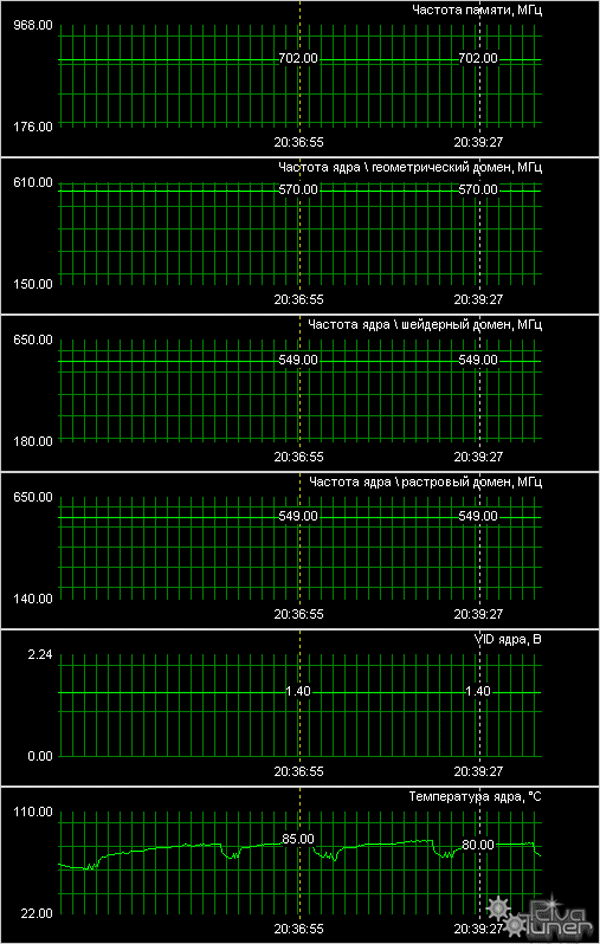 Memory chips are not equipped with heatsinks, but they do not get very hot. The situation with the XFX product is a tad different. The main feature of this card is its cooling system. Of course, increased frequencies are important as well. But all owners of Hi-End accelerators are concerned with the noise problem in the first place. This is THE FIRST HI-END ACCELERATOR OF THE GeForce 7800 GTX 512MB LEVEL WITH A PASSIVE HEATSINK, THAT IS IT HAS A FANLESS COOLER! It's very important. It's a system of two heatsinks, connected with heat pipes. Nothing new, isn't it? We have already seen similar devices, but not in accelerators of this level. The most powerful product with a passive cooler was the ASUS GeForce 7800GT Silent. But its performance is far from the level of our card under review. That's where the fanfares tail off, spirits sink, and our admiration transforms into terrible disappointment... Have a look at the monitoring results: 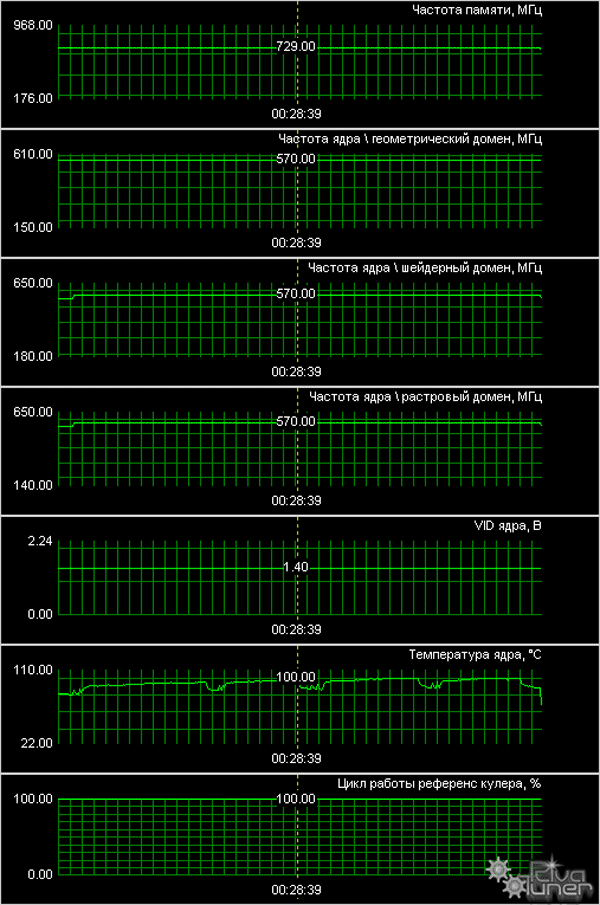 The GPU temperature grows to 100°C!!! We tested the cards in 3DMark06 in a closed Chieftec case with a standard case-fan configuration (one intake fan and one blow-out fan). That is all our hopes for noiseless operation burst like a soap-bubble. Yep, I understand that the card itself can work well at this temperature. It may even remain intact after that, but what about the other cards? They can get overheated, to say nothing of the heat that goes up from the card to a CPU. These results jarred on me. Increased frequencies? Nope, reducing the frequency to the standard level lowered the temperature to a couple degrees. That's unpleasant. We should do justice to the card: if we install a low-speed fan on this accelerator, the results get much better. The operating temperature does not exceed 85°C, demonstrated by the reference card. Besides, there is almost no noise from a fan running at 1500 rpm. But it's not easy to find such fans in stores. You may also get similar results by applying lower voltage to a fan. Considering that our reference card is a sample, we cannot describe its bundle and package. But we are going to examine the XFX product from this point of view.
Installation and DriversTestbed configuration:
VSync is disabled.
Test results: performance comparisonWe used the following test applications:
Summary performance diagramsNote that we have run two test sessions: of a single card and of the SLI mode (two accelerators).
Game tests that heavily load vertex shaders, mixed pixel shaders 1.1 and 2.0, active multitexturing.FarCry, Research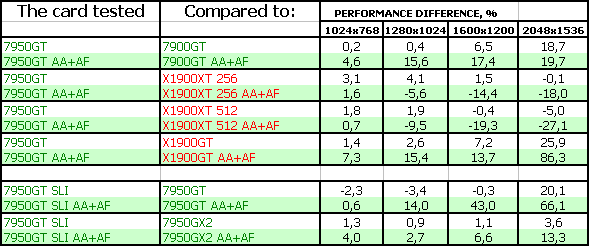
Game tests that heavily load vertex shaders, pixel shaders 2.0, active multitexturing.F.E.A.R.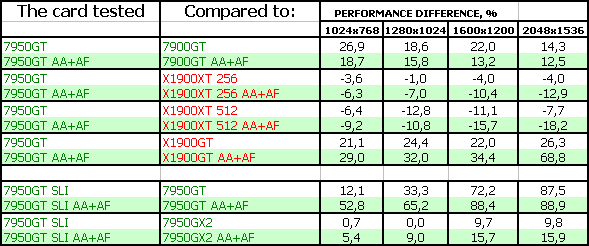
Splinter Cell Chaos Theory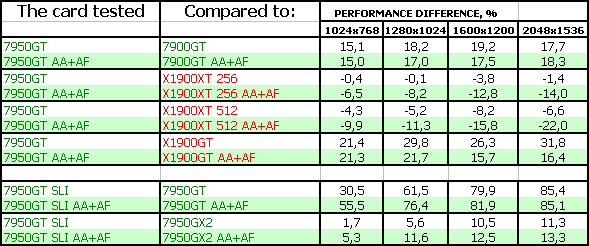
Call Of Duty 2 DEMO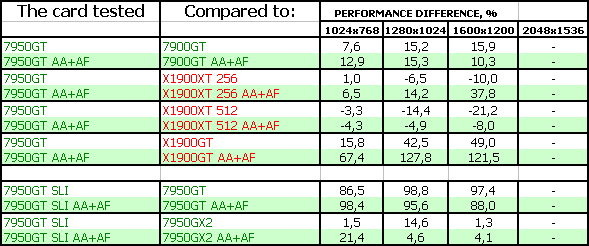 Half-Life2: ixbt01 demo
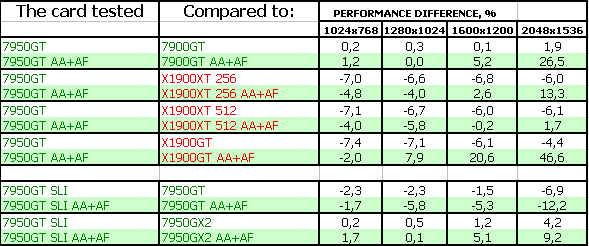
Game tests that heavily load pixel pipelines with texturing, active operations of the stencil buffer and shader unitsDOOM III High mode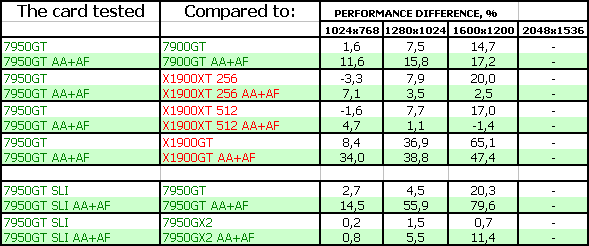 Chronicles of Riddick, demo 44
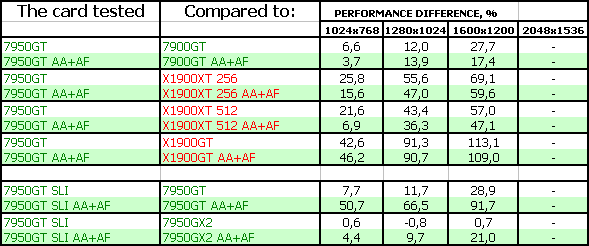
Synthetic tests that heavily load shader units3DMark05: MARKS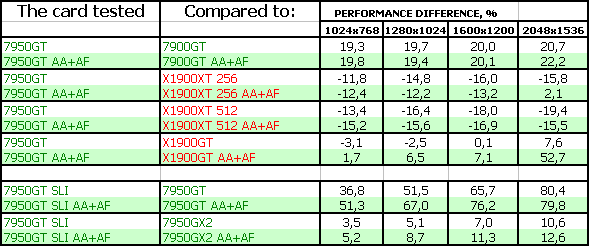 3DMark06: Shader 2.0 MARKS
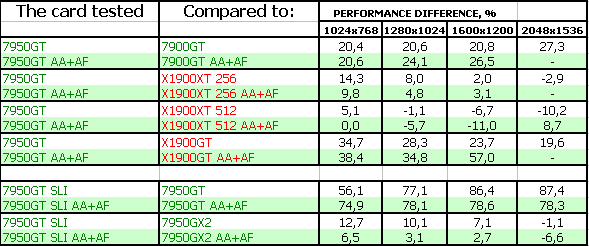 3DMark06: Shader 3.0 MARKS
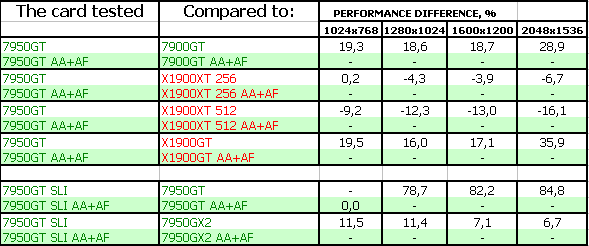 Unlike the previously tested GeForce 7900 GS, this situation is not quite clear. You can see well that competing accelerators are victorious in applications that load much shader units. Besides, ATI announced a considerable price drop for their cards. And the new X1900 XT 256MB demonstrates an excellent price/performance ratio. Of course, X1900-series products have a big drawback - a noisy cooling system. But they also have advantages, for example, AF of a higher quality. At the same time, you cannot ignore the fact that NVIDIA products are traditionally strong in games based on engines from id Software, like in OGL games. About SLI. I have already written that comparing SLI tandems is always much more difficult. First of all because they are not as popular as single cards. Another reason - not all users, who dream of a powerful accelerator, will install two NON-TOP products in SLI mode. A user most often sells his/her old accelerator and buys a new powerful card. It's also very difficult to evaluate the 7950 GT SLI, because single cards for $600 will soon disappear (until the launch of G80). Even the 7950 GX2 is going down in price. It will soon reach the $500 point. But nevertheless, our performance analysis shows that this tandem fairs well even against the 7950 GX2. That's true only in case of the recommended prices (it will be more expensive at first in real life). But don't forget that you need a motherboard with SLI support and a decent power supply unit. Conclusions
NVIDIA GeForce 7950 GT 512MB PCI-E. We have already made out point above. I cannot say that the card is better or worse than, for example, the X1900 XT. It will be up to the price again. If the 7950 GT appears in stores at a lower price than the X1900 XT, that's your choice. I again remind you that a small quiet cooler will do fine for the 7950 GT, though it gets very hot, unlike the 7900 GT. And the X1900 is equipped with a howling annoying cooler. It's a very difficult choice and it's up to our readers to make. By the way. I should remind you that according to multiple posts from various forums, there have recently appeared more defective GeForce 7900GTX and 7900GT cards, even those not overclocked by manufacturers. They freeze the operating system after some time (from 10 minutes to 1 hour) or cause inexplicable slowdowns, frequency drops without overheating problems, etc. So you should be very careful, when you buy such a card. You should find out the replacement rules of a given retailer before you buy it. I hope this bug (if it was a bug) is fixed in the 7950GT and it won't have such problems. This sample worked well, stability and 2D quality were up to the mark. XFX GeForce 7950 GT Extreme 512MB PCI-E. Well... What can I say? The card is OK! We even hired a brass band, trumpets blared, my colleagues envied me for the chance to test this prodigy of nature, they were even considering an idea to buy this card as soon as it appeared in stores. And then the disappointment... Engineers made a mistake, the load is too much for such a cooling system. The cooler must be reinforced. Perhaps by replacing all elements to copper counterparts or by installing a low-speed fan. Or by adding such a fan into the bundle to be mounted on a bracket (we have already seen such cases). We do not publish performance results of this card, because they are all higher by 10% than the reference ones. You can calculate them on your own. The other parameters - operating stability (even at such temperatures!), 2D quality - they are all excellent.
You can find more detailed comparisons of various video cards in our 3Digest.
We have been hesitating much as to what product to award. One thing is certain. The XFX product would have been awarded in our "Original Design" nomination, but for its problems with overheating. But we still decided that if you buy such a card, you can also buy a low-noise fan for it. Fortunately, they are cheap. So the XFX GeForce 7950 GT Extreme 512MB PCI-E still gets this award in October (you should keep in mind those increased frequencies). 
ATI RADEON X1300-1600-1800-1900 ReferenceNVIDIA GeForce 7300-7600-7800-7900 Reference
We express our thanks to
ZEON and Alexei Lebedev for the provided video card XFX GeForce 7950 GT Extreme 512MB PCI-E
Write a comment below. No registration needed!
|
Platform · Video · Multimedia · Mobile · Other || About us & Privacy policy · Twitter · Facebook Copyright © Byrds Research & Publishing, Ltd., 1997–2011. All rights reserved. | |||||||||||||||||||||||||||||||||||||||||||||||||||||||||||||||||||||||||||||||||||||